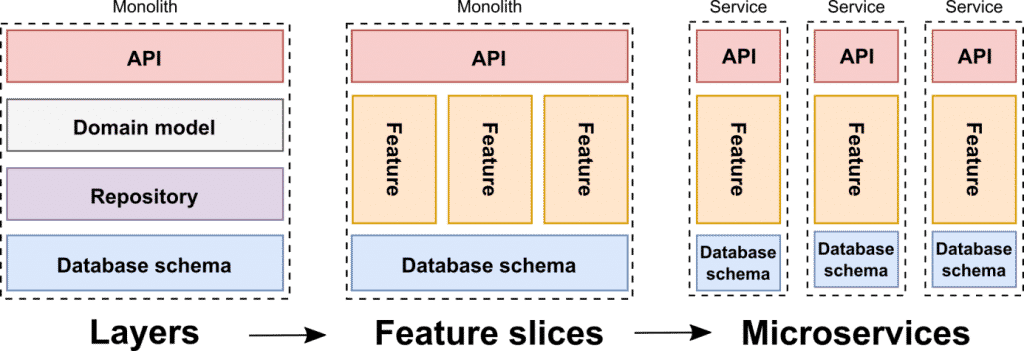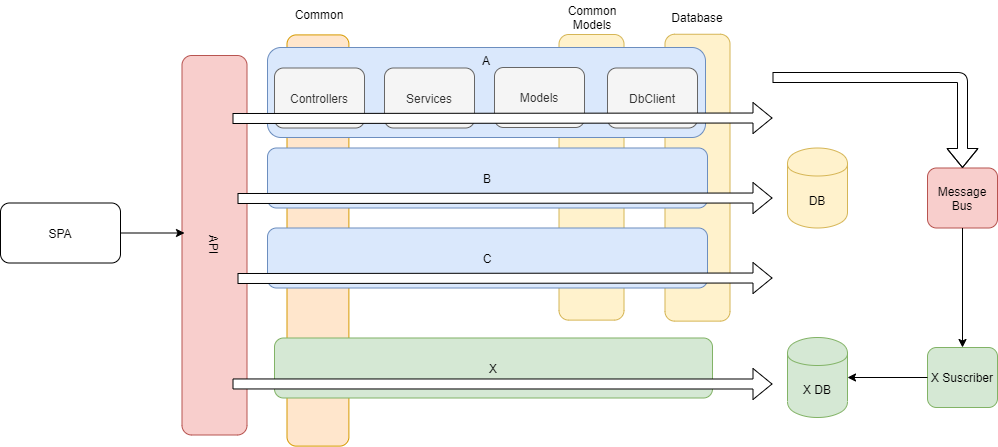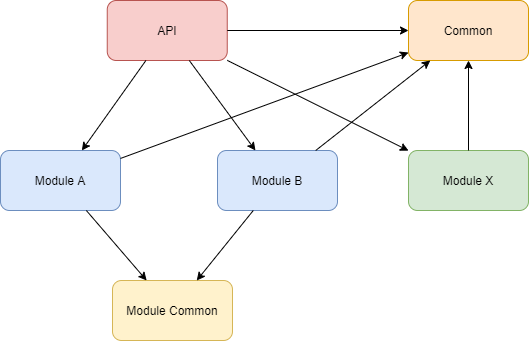Architectures - Feature Slices
Vertical (aka feature) slices (aka package by feature) structure the code around business aspects or features and not by the responsibility. In a larger project, this enables the code to be split into smaller parts, which makes the project structure easier to understand and more maintainable.
 Source: https://www.betterask.erni/news-room/slices-vs-layers/
Source: https://www.betterask.erni/news-room/slices-vs-layers/
In addition to what is shown in the previous image, features can also have their own APIs (routes) and database schemas, with each route being completely independent, much like a microservice, as illustrated in the next example.
Pros and Cons
Overall, organizing code using vertical slices can streamline development, improve collaboration, and make the codebase more manageable and adaptable to changes.
Pros
- Improved Maintainability:
- Vertical slices make it easier to understand and modify the codebase, especially for larger projects.
- Grouping related code together, vertical slices reduce the amount of context switching required to make changes, and they make it easier to identify and isolate problems.
- Reduced Coupling:
- Vertical slices minimize coupling between different parts of the codebase, making it easier to make changes to a specific feature without affecting unrelated parts.
- Enhanced Feature Independence:
- Vertical slices promote feature independence, which means that teams can work on different features without interfering with each other.
- This can lead to faster development cycles and better overall project coordination.
- Improved Developer Productivity:
- Vertical slices can improve developer productivity by making it easier to find and understand the code relevant to a specific task.
- This can reduce the time spent searching for code and debugging issues, leading to more efficient development cycles.
Cons
- Consisteny challenges:
- Maintaining consistent practices across slices can be challenging.
- Ensuring consistency requires good communication and following on agreed-upon standards.
- Potential for Duplication:
- Vertical slices may lead to code duplication, as similar functionality may be implemented in multiple features.
- This can increase the overall codebase size and make it more difficult to maintain consistency.
- Difficulty in Identifying Cross-Feature Dependencies:
- Identifying dependencies between features can be more difficult with vertical slices, as the code is organized around individual features rather than the overall system flow.
- Increased Complexity for Small Projects:
- For small projects with a limited codebase, vertical slices may introduce unnecessary complexity and overhead. In such cases, a simpler, flatter structure may be more suitable.
Feature Slice Example

Note: in some languages, it is easy to organize larger projects/solutions into smaller projects with packages/projects and in some languages, organization is done with folder structure.
- All features are in their own project
- Each project contains all configurations it needs to function
- Each project contains all endpoints
- No references / imports to other feature-projects
- References and imports only to Common-projects
- API (server) project loads all features and initialized the configurations
- API project has references to all features
- Feature-to-feature communication
- Message Bus
- In-process bus can be used if everything is running in a single API and single deployment (single process)
- Can be switched to an external bus if features would be separated into multiple APIs (processes)
- In-process bus can be used if everything is running in a single API and single deployment (single process)
- Injected services
- Modules can add exposed services to DI-container with interfaces / types defined in Common-projects
/common - ServiceX-interface - ServiceX-related types /moduleX - ServiceX-implementaion - Configuration - ServiceX added to the DI-container /moduleA - ServiceA uses ServiceX-interface (implementation injected from DI-container)- If services would be moved to own processes. Then ServiceA would need its own implementation of ServiceX (e.g. ServiceXClient implementing ServiceX-interface), which would call ServiceX-API instead of using Service directly.
- Message Bus
- Shared database is a bit tricky as some features have only a partial view of DB models
- e.g. A-module has full info of user (userId, addresses, contact info…), B-module only has partial info (userId and name).
- Entities are marked as Readable (partial) or as Writable (full) with corresponding interfaces (e.g. IReadable, IWriable)
- This way feature with a partial view of the DB-model, could not update it
Module / Project References

JS Project and Module Structure
JS modules should follow the same kind of reference policy
routes.ts
server.ts
...
common/
api.ts
db.ts
utils.ts
features/
featureA/
db.ts
models.ts
routes.ts
featureB/
...
featureX/
...
// e.g. /features/payments/payments.ts
import Api from './shared/api' // Seems fine to import this
import Api from '../../features/orders/lib/api'; // Hmmmm... Should I import this?
Node Hero - Project Structure Tutorial
Front-End Feature Grouping
- Each feature has its own routing configuration, business logic, models, API, views, etc.
- React: Grouping by features or routes
